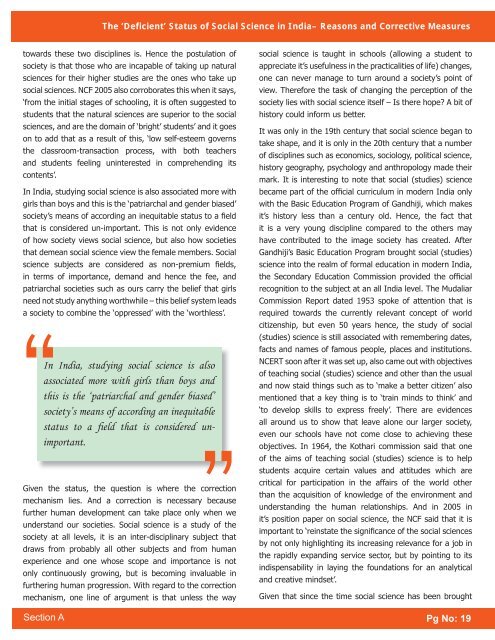Indesign Pagesnew.indd - Azim Premji Foundation
Indesign Pagesnew.indd - Azim Premji Foundation
Indesign Pagesnew.indd - Azim Premji Foundation
Create successful ePaper yourself
Turn your PDF publications into a flip-book with our unique Google optimized e-Paper software.
towards these two disciplines is. Hence the postulation of<br />
society is that those who are incapable of taking up natural<br />
sciences for their higher studies are the ones who take up<br />
social sciences. NCF 2005 also corroborates this when it says,<br />
‘from the initial stages of schooling, it is often suggested to<br />
students that the natural sciences are superior to the social<br />
sciences, and are the domain of ‘bright’ students’ and it goes<br />
on to add that as a result of this, ‘low self-esteem governs<br />
the classroom-transaction process, with both teachers<br />
and students feeling uninterested in comprehending its<br />
contents’.<br />
In India, studying social science is also associated more with<br />
girls than boys and this is the ‘patriarchal and gender biased’<br />
society’s means of according an inequitable status to a fi eld<br />
that is considered un-important. This is not only evidence<br />
of how society views social science, but also how societies<br />
that demean social science view the female members. Social<br />
science subjects are considered as non-premium fi elds,<br />
in terms of importance, demand and hence the fee, and<br />
patriarchal societies such as ours carry the belief that girls<br />
need not study anything worthwhile – this belief system leads<br />
a society to combine the ‘oppressed’ with the ‘worthless’.<br />
Given the status, the question is where the correction<br />
mechanism lies. And a correction is necessary because<br />
further human development can take place only when we<br />
understand our societies. Social science is a study of the<br />
society at all levels, it is an inter-disciplinary subject that<br />
draws from probably all other subjects and from human<br />
experience and one whose scope and importance is not<br />
only continuously growing, but is becoming invaluable in<br />
furthering human progression. With regard to the correction<br />
mechanism, one line of argument is that unless the way<br />
Section A<br />
The ‘Defi cient’ Status of Social Science in India– Reasons and Corrective Measures<br />
In India, studying social science is also<br />
associated more with girls than boys and<br />
this is the ‘patriarchal and gender biased’<br />
society’s means of according an inequitable<br />
status to a fi eld that is considered unimportant.<br />
social science is taught in schools (allowing a student to<br />
appreciate it’s usefulness in the practicalities of life) changes,<br />
one can never manage to turn around a society’s point of<br />
view. Therefore the task of changing the perception of the<br />
society lies with social science itself – Is there hope? A bit of<br />
history could inform us better.<br />
It was only in the 19th century that social science began to<br />
take shape, and it is only in the 20th century that a number<br />
of disciplines such as economics, sociology, political science,<br />
history geography, psychology and anthropology made their<br />
mark. It is interesting to note that social (studies) science<br />
became part of the offi cial curriculum in modern India only<br />
with the Basic Education Program of Gandhiji, which makes<br />
it’s history less than a century old. Hence, the fact that<br />
it is a very young discipline compared to the others may<br />
have contributed to the image society has created. After<br />
Gandhiji’s Basic Education Program brought social (studies)<br />
science into the realm of formal education in modern India,<br />
the Secondary Education Commission provided the offi cial<br />
recognition to the subject at an all India level. The Mudaliar<br />
Commission Report dated 1953 spoke of attention that is<br />
required towards the currently relevant concept of world<br />
citizenship, but even 50 years hence, the study of social<br />
(studies) science is still associated with remembering dates,<br />
facts and names of famous people, places and institutions.<br />
NCERT soon after it was set up, also came out with objectives<br />
of teaching social (studies) science and other than the usual<br />
and now staid things such as to ‘make a better citizen’ also<br />
mentioned that a key thing is to ‘train minds to think’ and<br />
‘to develop skills to express freely’. There are evidences<br />
all around us to show that leave alone our larger society,<br />
even our schools have not come close to achieving these<br />
objectives. In 1964, the Kothari commission said that one<br />
of the aims of teaching social (studies) science is to help<br />
students acquire certain values and attitudes which are<br />
critical for participation in the affairs of the world other<br />
than the acquisition of knowledge of the environment and<br />
understanding the human relationships. And in 2005 in<br />
it’s position paper on social science, the NCF said that it is<br />
important to ‘reinstate the signifi cance of the social sciences<br />
by not only highlighting its increasing relevance for a job in<br />
the rapidly expanding service sector, but by pointing to its<br />
indispensability in laying the foundations for an analytical<br />
and creative mindset’.<br />
Given that since the time social science has been brought<br />
Pg No: 19

















